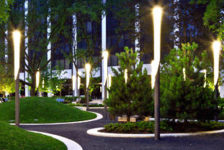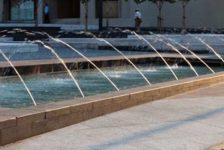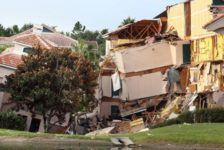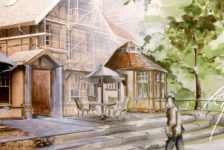Background
Here in early 2019, we find ourselves in a terrifying time. The evidence is astoundingly clear that the effects of climate change are worse than previously predicted and accelerating. If humanity is to avoid catastrophic, perhaps even unsurvivable climate change, we must end the use of fossil fuels as soon as possible.
However, if we were to do that, the resulting energy and civilizational transition would be the most dramatic ever undertaken by our species. Everything about our current way of life would change greatly.
But scientists are emphatic about the need to end using fossil fuels now. Prof David Reay, of the University of Edinburgh, says we must “act now or see the last chance for a safer climate future ebb away.”
The end of fossil fuels will usher in a “post carbon” era. It is “post carbon” because we can no longer do anything that releases carbon dioxide into the atmosphere, especially through burning fossil fuels.
Landscape architects must accept this reality.
Please understand that this is absolutely different than things labeled “green,” “sustainable,” “low carbon,” or even “net-zero.”
Post carbon landscape architecture means that there will be no use of fossil fuels for construction, transportation, or even the creation of many of the materials commonly used by landscape architects.
Obviously, this will fundamentally change our work.
Reaffirming what we do
Yet we must assume that the need for our work will only increase in the future. Therefore, it is imperative to state exactly what it is that landscape architecture should do.
Below is an initial attempt at descriptions of the broad ways in which landscape architecture will be essential in the post-carbon era.
- We are needed to design and build beautiful places that will nurture the healing and growth of authentic human communities and individual spirits.
- We are needed to help protect and restore systems that will help life to recover and flourish.
- We are needed to share our understanding of the earth’s cycles, processes and bioregions to sustainably meet our elemental needs.
- We are needed to help us creatively adapt to the challenges of the Anthropocene, such as rising sea levels, fires, droughts, human migration, habitat loss, pollution, (and unfortunately), etc.
I’m sure there are some other categorizations as well as many subsets.
The key thing is this: None of these activities intrinsically require fossil fuels.
Landscape architecture has been practiced for millennia. Certainly, much of that work was in the service of power, and the benefits were directed to elites. Nonetheless, there have been significant positive interactions with the land that did not require the use of fossil fuels. My point is that it is possible.
Take Central Park, for example. America’s greatest public space was built without fossil fuels. Instead, Olmsted’s vision of democracy-made-visible was built primarily with the muscles of animals (human and otherwise).

Central Park, 1869
It was not perfect, as demonstrated by the removal of Seneca Village, one of New York City’s few African-American middle-class communities, to make way for the park. We must never repeat such injustices. But as a symbol of what is physically possible without using fossil fuels, we can do no better than to study Central Park.
Reframing how we work
Fossil fuels have only been fully embedded in the work of landscape architecture for 100 years or so, and then only as a means to our desired ends. Our profession must now reframe our understanding of the means used to create our desired ends. What a wonderful creative challenge!
Understanding the limits of the post carbon era should be our first response. First, we will have much less energy to use. Ending fossil fuels will eliminate 80% of our current energy supply. While renewable power will no-doubt increase, it cannot replace all the energy of fossil fuels. We must break out of our 20th century “have-it-all” mindset: future energy supply will not meet our wants.
Renewables produce electricity, not fire, and only intermittently. There will be many claims on the resulting electricity distribution. This energy-limited future will require us to embrace both radical simplicity and radical sufficiency.
Next, the post carbon era will mean an end to most of the construction methods and material choices we now take for granted.
Today, landscape architects rely on fossil-fueled machines to do most of our heavy work for us. We rely on large amounts of materials, such as concrete, metals, and plastics, all of which cannot be produced without large emissions of carbon dioxide. In the post carbon future, we will have neither those machines nor much of those materials.
We must rediscover low energy and labor efficient methods. Think clever low tech, and locally sourced, appropriate materials.
All this will require us to reimagine design.
First, we must design for only those things that must be done.
In the post carbon era, we will do well to heed Olmsted’s direction that “service must precede art…” (To quibble, I would rearrange that somewhat to say that we should engage in “artful service.”)
And then we must be creative in planning and specifying construction that can be built without emissions of any sort.
Perhaps we should emulate birds. Many species build intricate, beautiful nests with only what is near, and with only what they are able to carry.
We too should practice a “small, light, and local” design and construction philosophy.
Perhaps too, we should emulate beavers – nature’s ecosystem engineers. Beavers certainly build to suit themselves – like us – but their work also benefits the life and life support systems around them. Their work is a eco-positive, unlike, too often, ours. To paraphrase and expand on Milenko Matanovic’s vision, we must work for “multiple victories” on every project.
Further, we must ensure that our projects incorporate copious plant material and soil building activities. That is not to offset our own project’s emissions, but to be able to sequester some of the excessive carbon dioxide now in the atmosphere. This is “Drawdown,” and it will be an operative principle for us from now on.
Landscape architecture education must change to facilitate this. We need an increased focus on integrated ecological design, fossil fuel free materials and construction, and the research that will support the post carbon profession.
Landscape architecture practice will necessarily change as well. In the lower energy future, distance will matter a great deal. This will not only affect our practice sheds, but our material supplies and labor force.
Finally, our ethics must evolve. Ending fossil fuels will mean a return to the use of muscles in much of our needed work (human and otherwise). We must be very aware of this reality and create the ethical standards by which to value and protect those that do the work. ASLA, for example, does not have an explicit position on labor (human and otherwise).
Additionally, we must hold ourselves accountable to more exacting standards of social and environmental justice to ensure that what we are doing is for the greatest benefit for all communities.
What won’t work
The alarms are going off. But many people, landscape architects included, assume that “solving” climate change will not require dramatic changes. There is a belief that technology can be employed to enable us to basically continue as we are now.
Unfortunately, there is no technology on the horizon that will suck from the atmosphere – at the needed scales and time frames – the excess carbon dioxide that is causing us harm and then safely lock it away deep underground, for thousands of years.
Nor is there any realistic type of geo-engineering that could somehow deflect the sun’s rays to keep us cool. Anyway, we’re already performing one scary experiment with the climate, we don’t need to add another.
So, if technology is not riding to the rescue, what other options are there?
Simply hoping for a something to work out is irresponsible. Ignoring the threat is morally indefensible. And our current baby steps to reduce carbon emissions will, to quote Alex Steffen, “guarantee defeat.”
The only realistic ways to avoid climate catastrophe are to immediately end fossil fuel use, stop deforestation, and begin vigorously restoring carbon sinks. Doing this will also give us a chance to reverse the existential damage we’ve done to the rest of life on this planet.
But what if no one else quits fossil fuels? What should landscape architects do?
Kathleen Dean Moore puts it best in reference to all of us as citizens: “If we don’t respond to the emergency, we become part of the storm itself.”
Which side of history should landscape architects be on?
Moving forward
Landscape architects are desperately needed for the future we are entering. We must recommit to do our needed things with great imagination, courage, and justice. We must support each other and our communities as we undertake this challenge. Let’s be leaders for the world as it must become.
—
Lead Image: © Steve Austin (used with permission)













Linda Ashby
So glad to see you continuing this important work, Steve! Looking forward to your conference session at the Washington-ASLA Annual, March 22 in Tacoma!
steve austin
thanks Linda – see you in Tacoma
J. Robert (Bob) Wainner
Sorry Steve, but, I have to disagree with your “Utopian theories” in your article. If we were to say, eliminate 100% of the OIL in America…eliminate all vehicles, aircraft, ships, etc. that use fossil fuels……it would mean going 100% Electric. Manufacturing “batteries” also pollutes our atmosphere. Besides, WHO is going to force China, Russia, India and all of the other 3rd World nations to live by YOUR Standards…..answer, nobody. And, if you take away all of the gasoline, millions of Americans will own cars they can no longer drive. Are you going to buy us ALL a new car…maybe an expensive Tesla?
Like it or not….the entire World’s economy is very much dependent on the OIL & GAS Industry (and COAL). We can of course advocate for change….and a variety of types of energy….but, IMO, it’s totally unrealistic to eliminate all fossil fuels.
Al Gore is now worth over $200 Million……because, he pushed the “Global Warming Theory”….which is a myth. Climate Change is real…has been here on Earth, since the beginning of time (way before mankind inhabited our Planet). I really wish to meet the men and women who will actually be capable of changing the Earth’s Climate Changing Process.
Why is it that I continue to read these very Liberal articles on LAND 8…..how Landscape Architect’s MUST “save our Planet”. Realistically, I believe Landscape Architects are become less relevant in our Society…..and I find that very sad and disturbing…but, true.
IMO, University Landscape Architecture Professors need to be teaching young LA students…..”realistic” solutions to our environmental challenges…..not concepts that you can only find when watching a very futuristic SCI-FI Movie. But, it’s FUN to at least “dream” of the impossible.
Sincerely,
J. Robert (Bob) Wainner
J. Robert (Bob) Wainner
P.S. from J. Robert (Bob) Wainner;
The thinking in this article……that we “must” eliminate 100% fossil fuels……is the SAME concept that Alexandria Ocasio-Cortez’s NEW GREEN DEAL. This is a really “ridiculous” concept…..period. Yes, CO2 emissions are not good for our Nation…but, 3 of the TOP cities with the most CO2 emissions are Los Angeles, San Francisco & New York City…all 3 cities are VERY Liberal cities. WHY don’t the citizens of these communities do something about their terrible CO2 emissions problems??? Yes, America as a whole also has CO2 emission problems….but, to do away with 100% of cars, passenger jets and cows…..is not only ridiculous, but, does everyone realize how many millions of LOST JOBS that would cost Americans?!!! And, what that would do to the American economy! I think we need to take a hard look at CHINA’s CO2 emissions issues. CHINA is the worst Nation on the planet when it comes to CO2 emissions….CHINA is produces twice the amount America puts out.
And, in my opinion, going with Electric Cars and High speed trains…..is just not the answer. I think America is easily 100 years away from any of that. Tesla’s cars MSRP start around $74,000.00 and go up to $130,000.00 (that’s not affordable or practical for a vast majority of American citizens). Tesla is “trying” to develop a $30k car, but, is having major issues with the production and reliability process….doubt if they’ll be able to develop a Tesla in that price range.
In addition, putting the OIL & Natural Gas Industries out of business is ridiculous. OIL literally drives the “Economy” of the entire Planet.
Until the other Nations of the World take CO2 emissions seriously…….we will NEVER resolve this issue on our Planet. And, there is nobody who will or can force other Nations to comply.
Personally, I enjoy riding bicycles…..but, I don’t think America is ready to exchange their gasoline cars for either electric cars or bicycles for transportation yet. So……if anyone is waiting for or hoping for a “POST CARBON LANDSCAPE ARCHITECTURE” World…..you have to believe, this is only a “theory” and not a very practical one at that.
Angelo Zielinski
Steve,
While I can appreciate your passion, I wonder if your tone isn’t a bit counterproductive. Study after study show that such hyperbolic “dooms day” messages only serve to entrench people in their views, and do little to persuade anyone.
Your (very strong) opinions are fine, but please be cautious not to allow them to eclipse the facts, less your message read like a transcript of the sidewalk proclamations from some guy wearing a sandwich board that reads “THE END IS NEAR!”
robert
Brilliant Steve Austin, Your blog about landscape architecture very nice. Keep it up. I am also an architecture designer.
Visit:http://www.teamdesigns.ca/